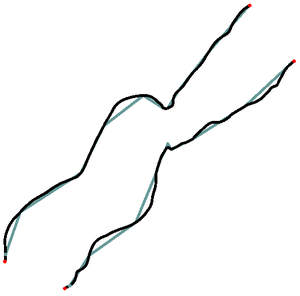SMS:Floodway Delineation: Difference between revisions
From XMS Wiki
Jump to navigationJump to search
| Line 3: | Line 3: | ||
==Floodway Dialog== | ==Floodway Dialog== | ||
[[File:Floodway dialog in SMS.png|thumb|right| | [[File:Floodway dialog in SMS.png|thumb|right|350 px|The ''Floodway'' dialog in SMS]] | ||
The ''Floodway'' tool in SMS is used to delineate approximate floodway extent arcs based on the geometry of the mesh, scatter set, or Cartesian grid used in the project. It is accessed by right-clicking on the 1D hydraulic centerline coverage and selecting '''Floodway...''' to bring up the ''Floodway'' dialog (right). | The ''Floodway'' tool in SMS is used to delineate approximate floodway extent arcs based on the geometry of the mesh, scatter set, or Cartesian grid used in the project. It is accessed by right-clicking on the 1D hydraulic centerline coverage and selecting '''Floodway...''' to bring up the ''Floodway'' dialog (right). | ||
Revision as of 19:16, 17 August 2022
Floodway delineation is the process by which an area is marked for use as a floodway. The Federal Emergency Management Agency (FEMA) defines a floodway as follows:
A "Regulatory Floodway" means the channel of a river or other watercourse and the adjacent land areas that must be reserved in order to discharge the base flood without cumulatively increasing the water surface elevation more than a designated height.[1]
Floodway Dialog
The Floodway tool in SMS is used to delineate approximate floodway extent arcs based on the geometry of the mesh, scatter set, or Cartesian grid used in the project. It is accessed by right-clicking on the 1D hydraulic centerline coverage and selecting Floodway... to bring up the Floodway dialog (right).
- Floodway method
- Option to select method used for floodway delineation: "Equal conveyance on cross sections method" or "Unit discharge method".
- Geometry
- A mesh or scatter set must be selected. Click Select... to bring up the Select Tree Item dialog. It will display any appropriate datasets.
- Depth
- A depth dataset must be selected. This dataset should the one from under the selected mesh. Click Select... to bring up the Select Tree Item dialog. It will display any appropriate datasets.
- Velocity
- A velocity dataset must be selected. This dataset should the one from under the selected mesh. Click Select... to bring up the Select Tree Item dialog. It will display any appropriate datasets.
- Cross Section Coverage
- A cross section coverage must be selected. Click Select... to bring up the Select Tree Item dialog. It will display any applicable map coverages.
- WSE Maximum Rise
- The target maximum rise in water surface elevation. FEMA's maximum allowable rise criterion is 1 foot or less. The default value is "1.0".
- WSE Minimum Rise
- The target minimum rise in water surface elevation. The Floodway tool uses the minimum rise input as a lower bound for the computed rise as it iterates through the calculations. Setting a larger difference between the minimum and maximum values yields a more loosely defined floodway delineation. It is typically recommended that this value be set close to the target maximum rise. The default value is "0.9995".
- Number of Divisions
- This determines the number of vertices and sections created in each arc used to define the floodway.
- Use flow trace
- Checking this box turns on flow trace. Flow trace will create smoother floodway extent arcs between each cross section by using the 2D datasets to trace a flow path between each cross section. The image to the right shows a good example of this. The black lines used flow trace, and the greenish lines did not.
References
- ^ "Floodway". Federal Emergency Management Agency. July 18, 2017. https://www.fema.gov/floodway. Retrieved on January 10, 2018.
Related Topics
SMS – Surface-water Modeling System | ||
|---|---|---|
| Modules: | 1D Grid • Cartesian Grid • Curvilinear Grid • GIS • Map • Mesh • Particle • Quadtree • Raster • Scatter • UGrid |  |
| General Models: | 3D Structure • FVCOM • Generic • PTM | |
| Coastal Models: | ADCIRC • BOUSS-2D • CGWAVE • CMS-Flow • CMS-Wave • GenCade • STWAVE • WAM | |
| Riverine/Estuarine Models: | AdH • HEC-RAS • HYDRO AS-2D • RMA2 • RMA4 • SRH-2D • TUFLOW • TUFLOW FV | |
| Aquaveo • SMS Tutorials • SMS Workflows | ||

